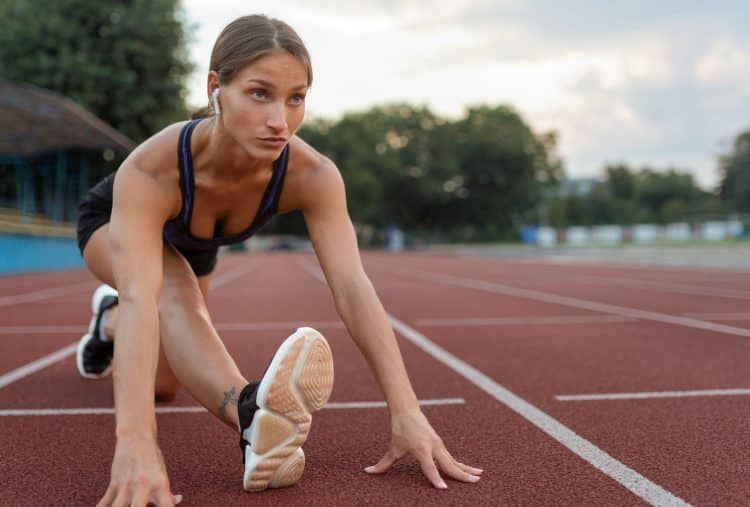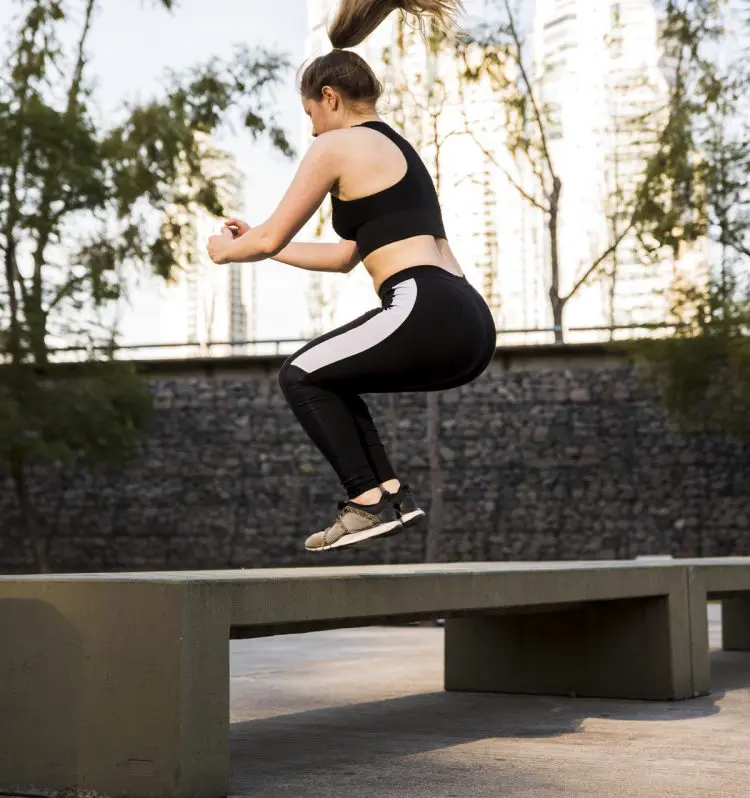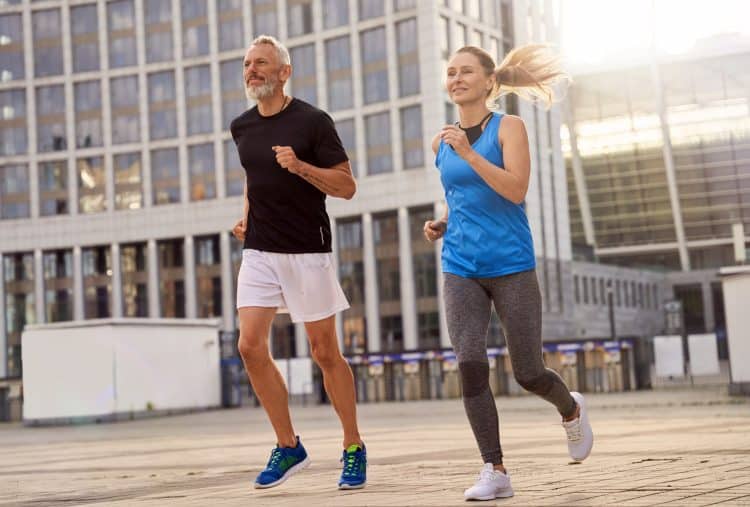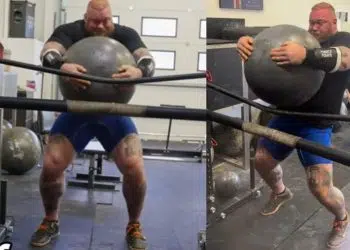As humans, we are fascinated with everything fast — from cars and bikes to animals. This is also why 100 and 200-meter races are among the most popular events at track and field competitions.
Whether you are a pro athlete or a hobbyist exerciser, knowing about the average human running speed can help you design your training programs and set achievable goals.
I have my advanced personal training clients who are training for a marathon run a 5K to assess their running speed. I then have them compare it to the average human running speed and the average speed of the best marathon runners. This small exercise gives them a clear idea of how they stack up against their peers and what they can expect in a contest.
In this article, we will delve into the average human running speed, average running speeds by distance, average sprinting speeds, age, and running speeds, and how you can improve your running speed.
We have a lot of speed to cover, so sit tight and fasten your seatbelt.
Average Human Running Speed
Level Up Your Fitness: Join our 💪 strong community in Fitness Volt Newsletter. Get daily inspiration, expert-backed workouts, nutrition tips, the latest in strength sports, and the support you need to reach your goals. Subscribe for free!
Average running speed can depend on several factors, including distance, time, heart rate, gender, age, and athletic capabilities. For example, an individual running a 200-meter race will have a vastly difference average running speed than an athlete running a marathon.
With over 95 million users, the physical exercise tracking app Strava is among the most enormous resources on the planet for analyzing fitness trends. The average running speed on Strava between August 1, 2022, and July 30, 2023, was 10 minutes and 25 seconds (10:25). This number breaks down to a 10:02 mile pace for men and 11:17 for women.
That said, Strava is a community of dedicated fitness enthusiasts. You shouldn’t fret if your numbers are nowhere close to the Strava average. Don’t bite off more than you can chew early in your training regimen. Give yourself enough time to adjust to your workouts, and you will reap the rewards.
How To Track Your Average Running Speed
Tracking your mile pace is the easiest way to determine your average running speed. There are numerous ways of doing it. You could use a wearable tracker like a smartwatch or the built-in tracker in your smartphone.
I recommend all my clients track their runs in a fitness app. Some of my favorites include Strava, Nike Run Club (NRC), and the native Apple Fitness app. Using a dedicated running app allows you to track various metrics, which can help improve your performance in the long run.
That said, you must run at least three miles on a single stretch to determine your mile pace and average running speed. Most people tend to dash through their first mile, which can lead to skewed average running speed data.
When running three miles, you might start with a full-send effort, but most runners slow down after the first mile when they realize they have two more miles to complete. The running pace in the second and third miles will set your average running speed.
Pro Tip: Always analyze your split times while assessing your running pace. Most people start fast, slow down in the middle, and pick up pace in the final stretch. Knowing your split times can help improve your running performance in the long term.
How Fast Can a Human Run?
Now that you know the average human running speed, it is natural to be curious about the fastest running speed clocked by a human.
Jamaican athlete Usain Bolt is widely regarded as the best human sprinter of all time. He finished the 100-meter sprint during the 2009 World Championships in Berlin in a record 9.58 seconds. Bolt’s average running speed during this 100-meter world record run was around 23.35 miles per hour (37.58 kph). Bolt clocked 27.78 mph (44.72 kph) between meter 60 and meter 80. (1)
American track and field star Florence Griffith-Joyner has held the record for the fastest woman for over 30 years. Griffith-Joyner ran the 100-meter dash in 10.49 seconds at the U.S. Olympic Trials in Indianapolis, Indiana, in 1988 (2). Griffith-Joyner averaged 21.3 mph (34.3 kph) during the race.
Use our online running pace calculator to determine your running speed.
Average Mile Time For Male and Female Runners
Although the numbers from Bolt and Griffith-Joyner are motivating, you shouldn’t try to replicate them in your next run; it will only end up in disappointment or a pulled hamstring (or worse, both).
Running Level, a site dedicated to calculating and assessing your running performance, has come up with average mile time for runners based on gender and running experience. Check them out below:
Average Mile Times for Males By Age and Ability
Here is the average mile time for males as per their experience level:
| Age | Beginner | Novice | Intermediate | Advanced | Elite | WR |
| 10 | 11:16 | 09:20 | 07:55 | 06:54 | 06:09 | 04:31 |
| 15 | 09:45 | 08:05 | 06:51 | 05:58 | 05:19 | 03:55 |
| 20 | 09:25 | 07:48 | 06:38 | 05:46 | 05:08 | 03:47 |
| 25 | 09:25 | 07:48 | 06:38 | 05:46 | 05:08 | 03:47 |
| 30 | 09:26 | 07:49 | 06:38 | 05:46 | 05:09 | 03:47 |
| 35 | 09:35 | 07:56 | 06:44 | 05:52 | 05:14 | 03:51 |
| 40 | 09:55 | 08:13 | 06:58 | 06:04 | 05:25 | 03:59 |
| 45 | 10:17 | 08:31 | 07:14 | 06:18 | 05:37 | 04:08 |
| 50 | 10:42 | 08:51 | 07:31 | 06:33 | 05:50 | 04:18 |
| 55 | 11:08 | 09:13 | 07:49 | 06:49 | 06:04 | 04:28 |
| 60 | 11:36 | 09:37 | 08:09 | 07:06 | 06:20 | 04:39 |
| 65 | 12:07 | 10:02 | 08:31 | 07:25 | 06:37 | 04:52 |
| 70 | 12:43 | 10:32 | 08:57 | 07:47 | 06:57 | 05:07 |
| 75 | 13:40 | 11:19 | 09:37 | 08:22 | 07:28 | 05:29 |
| 80 | 15:08 | 12:32 | 10:38 | 09:16 | 08:15 | 06:04 |
| 85 | 17:25 | 14:26 | 12:15 | 10:40 | 09:30 | 07:00 |
| 90 | 21:13 | 17:35 | 14:55 | 12:59 | 11:35 | 08:31 |
The average mile time for men across all experience levels improves from ages 10 to 20 and stagnates till 25. However, the average mile time deteriorates each year as males cross the 30-year mark.
Average Mile Times for Females By Age and Ability
Check out the average mile time for women according to their age and experience level:
| Age | Beginner | Novice | Intermediate | Advanced | Elite | WR |
| 10 | 12:29 | 10:32 | 09:03 | 07:57 | 07:08 | 04:56 |
| 15 | 11:12 | 09:27 | 08:08 | 07:08 | 06:24 | 04:26 |
| 20 | 10:40 | 09:00 | 07:44 | 06:48 | 06:06 | 04:13 |
| 25 | 10:40 | 09:00 | 07:44 | 06:48 | 06:06 | 04:13 |
| 30 | 10:40 | 09:00 | 07:44 | 06:48 | 06:06 | 04:13 |
| 35 | 10:44 | 09:04 | 07:47 | 06:50 | 06:08 | 04:15 |
| 40 | 10:58 | 09:15 | 07:57 | 06:59 | 06:16 | 04:20 |
| 45 | 11:21 | 09:35 | 08:14 | 07:14 | 06:29 | 04:29 |
| 50 | 11:56 | 10:04 | 08:40 | 07:36 | 06:49 | 04:43 |
| 55 | 12:37 | 10:39 | 09:10 | 08:02 | 07:13 | 04:59 |
| 60 | 13:24 | 11:18 | 09:43 | 08:32 | 07:39 | 05:18 |
| 65 | 14:16 | 12:02 | 10:21 | 09:05 | 08:09 | 05:38 |
| 70 | 15:15 | 12:52 | 11:04 | 09:43 | 08:43 | 06:02 |
| 75 | 16:23 | 13:50 | 11:53 | 10:26 | 09:22 | 06:29 |
| 80 | 17:44 | 14:58 | 12:52 | 11:18 | 10:08 | 07:01 |
| 85 | 19:59 | 16:51 | 14:30 | 12:43 | 11:25 | 07:54 |
| 90 | 24:05 | 20:19 | 17:28 | 15:20 | 13:45 | 09:31 |
Like their male counterparts, the average mile pace for women of all experience levels improves between 10 and 20. However, it plateaus until the age of 30 and begins slipping after 35.
Use these numbers as a benchmark to assess your running abilities. However, don’t compare yourself to others. Beginners should share these numbers and their training objectives with a performance coach to ensure they effectively target all the key benchmarks.
Average Distance and Race Times
The running-dedicated website Run Repeat compiled data based on 35 million results collected in the last 20 years from more than 28,000 races. Given below are the average finish time, average pace, and men’s and women’s average finish time and pace:
| Distance | Average Finish Time | Average Pace | Average Men’s Finish Time | Average Men’s Pace | Average Women’s Finish Time | Average Women’s Pace |
| 5K | 0:34:37 | 11:09 | 0:31:28 | 10:08 | 0:37:28 | 12:04 |
| 10K | 1:02:08 | 9:59 | 0:57:15 | 9:13 | 1:06:54 | 10:46 |
| Half-Marathon | 2:14:59 | 10:18 | 1:59:48 | 9:08 | 2:24:03 | 10:59 |
| Marathon | 4:26:33 | 10:10 | 4:14:29 | 9:42 | 4:42:09 | 10:46 |
This table details the average human running speed to complete a 5K, 10K, half marathon, and a marathon.
Level Up Your Fitness: Join our 💪 strong community in Fitness Volt Newsletter. Get daily inspiration, expert-backed workouts, nutrition tips, the latest in strength sports, and the support you need to reach your goals. Subscribe for free!
This table gives you solid data points to compare your average running speed. Beginners should aim to hit the average finish time and pace for their gender and distance. Advanced runners can use the average mile times in the above section as a benchmark to improve their performance.
Importance of Understanding the Average Human Running Speed
Running is a fundamental form of exercise that transcends age, gender, and athletic capability. The versatile exercise is used in various forms of competition, involving varying pace and intensity.
Running is a numbers-based sport, which involves measuring your speed, cadence, distance, splits, heart rate, and time. You must be on top of your average running speed to boost your performance.
Knowing and understanding the average human running speed goes beyond athletic curiosity and is crucial to sports science and personal fitness, which can help improve your physical performance.
Knowing the average human running speed can help amateur runners, and fitness enthusiasts set realistic goals and benchmarks for personal improvement. It also provides a framework for measuring one’s progress. The average human running speed insights can help coaches and trainers design tailored training programs for their clients per their age groups and skill levels.
Knowing average running speeds is vital for strategy formulation in competitive sports, especially in track and field, marathon running, or triathlon. It can help assess the competition and set pace strategies.
Factors Affecting Average Human Running Speed
Some of the factors that influence running speed include:
- Muscle composition: An individual’s muscle fiber composition can significantly affect their running speed. Fast-twitch fibers (Type II) are crucial for sprinting, and slow-twitch fibers (Type I) are better for endurance.
- Training and technique: Using proper running form and technique can help boost your running efficiency and speed. Drill your running mechanics before setting out for bigger runs (5K, 10K, half marathon, and marathon).
- Biomechanics: Your stride length and frequency, joint flexibility, and limb coordination play a crucial role in determining your running speed.
- Genetics: Genetics dictate several factors on this list, including muscle and body composition and biomechanics.
- Body composition: A lower body fat percentage can contribute to better running efficiency.
- Age and sex: As demonstrated above, running speed peaks close to the late 20s and early 30s. Men usually hit peak running speed faster than females.
- Nutrition and hydration: Eating a balanced diet and staying hydrated throughout the day will keep you fueled, which can improve your running speed.
- Psychological factors: Achieving maximal speed requires pushing yourself to the limit, which can test your mental toughness, motivation, and ability to endure pain and discomfort.
- Environmental conditions: Environmental conditions can affect your running performance. Running at a high altitude or in extreme heat or cold can hamper your performance.
- Health and physical condition: Injuries, poor cardiovascular conditioning, or other health issues can negatively affect your running performance.

Age and Average Human Running Speed
The physiological changes that occur as humans age can impact running speed. As you saw in the tables above, the average human running speed generally declines as an individual crosses the 35-year mark. The dynamics of this decline vary and are influenced by many factors, including muscle composition, cardiovascular health, and overall physical fitness.
Children exhibit a gradual increase in running speed in their early years due to the growth and development of their muscular and skeletal systems. Most individuals hit their running speed peak in their mid-20s as their body is at their prime in terms of muscle mass, metabolic efficiency, and physical resilience.
There is a gradual decline in running speed around the age of 30 due to the natural aging process, where muscle mass starts to diminish, and the body’s overall physiological capabilities take a hit. This decline in muscle mass, known as sarcopenia, hampers the body’s ability to generate force and maintain high running speeds.
Plus, aging affects the cardiovascular system. There is a decrease in maximum heart rate and a reduction in the body’s ability to efficiently utilize oxygen during intense activities like running, which can lower your endurance and speed.
A review published in Sports Med concluded that older athletes who maintain a consistent training regime can continue to exhibit remarkable athletic performances, often outperforming their less active counterparts by a significant margin. (3)
Training for Running Speed Improvement
Here are a few tips and strategies to enhance your running speed:
Interval Training is Key
Incorporating cardio-focused high-intensity interval training (HIIT) into your workout regimen pushes your body to adapt to higher speeds. Your cardio HIIT workouts can comprise short bursts of sprinting followed by periods of jogging or walking.
Strength Training Can Boost Your Speed
Most elite sprinters have jacked physiques, especially lower bodies. Muscle mass in the lower body helps these athletes quickly generate significant power. Since hypertrophy is not the primary objective of a running training program, you can strength train two to three times weekly. Plus, you can perform strength training exercises as a part of the HIIT workouts to speed up your sessions.

Focus on Technique Refinement
Proper running form can significantly improve your running speed and reduce your risk of injuries. You must maintain a relaxed posture, optimize stride length, and ensure efficient foot placement. Remember, the optimal technique for each individual will vary depending on their body mechanics. Work with a running coach if you struggle to improve your running speed or experience redundant aches and pains.
Be Consistent
The importance of consistency in training cannot be overstated. You must stick to a regimented training program for gradual performance improvements. That said, make sure you’re not training yourself into the ground. Give your body enough time to recuperate from your training sessions.
Avoid Overtraining
Overtraining increases your risk of injury. You must learn to listen to your body. Feel free to skip a training session if you feel drained and exhausted. Conversely, you must incorporate variety in your workouts to keep your training sessions fun and exciting.
Nutritional Aspects of Running Performance
The importance of a balanced nutrition program is often overlooked while trying to improve running speed. Eating a healthy diet and meeting your daily micro and macronutrient (carbs, protein, and fat) goals improves your recovery, which helps build muscle tissue, strength, endurance, and speed and lowers the risk of injuries.
Carbohydrates are essential for maintaining ample glycogen stores, which the body uses as an energy source during extended runs. Protein aids in muscle repair and growth and keeps your body from entering a catabolic (muscle loss) state during long runs. A healthy dose of fat in your diet ensures optimal joint health and overall functioning.
Runners must also ensure proper hydration throughout the day to maintain their electrolyte balance and avoid the risk of cramps and quick fatigue. Athletes should also focus on nutrient timing to improve their performance. Consume easily digestible carbs before a training session for energy and fast-digesting protein foods after a workout for optimal muscle recovery.
Psychological Factors in Running
Running, especially long-distance or sprints, is as psychologically demanding as it is physical. Mental resilience and a positive mindset can significantly enhance a runner’s ability to endure discomfort, maintain pace, and achieve goals.
You can develop mental resilience for better running performance in the following ways:
Mindfulness and Visualization
Mindfulness involves being present and focused during your runs. It can help manage pain and fatigue. Listening to podcasts or meditative music can help you be mindful during your running practice. Conversely, visualization involves imagining yourself going through the different phases of the run before hitting the pavement.
Set Achievable Goals
Setting unrealistic goals can crush your motivation and lead to disappointment when you fail to achieve your objectives. Setting achievable and incremental goals is essential for long-term success and sticking to your running practice. It will help you stay motivated and build mental resilience.
Managing Stress and Anxiety
Long or quick runs can cause stress and anxiety. Practicing deep breathing before a run can help you relax, which can improve your running speed. Working with a running coach can also help control stress and anxiety.
Conclusion
I cannot stress enough the importance of tracking your runs, whether in training or competition. Tracking your running speeds and times will help you assess your running progress in real-time. It will help you to search for and set new goals, keeping you glued to your running practice. Watching your 1-mile run turn into a 5K, 10K, half marathon, and a marathon is exhilarating.
If you have any questions about your running pace and how to improve it, drop them in the comments below, and I will be happy to help.
References
- Kinugasa R, Usami Y. How Fast Can a Human Run? – Bipedal vs. Quadrupedal Running. Front Bioeng Biotechnol. 2016;4:56. Published 2016 Jun 30. doi:10.3389/fbioe.2016.00056
- Britannica, T. Editors of Encyclopaedia (2023, November 9). Florence Griffith Joyner. Encyclopedia Britannica. https://www.britannica.com/biography/Florence-Griffith-Joyner
- Maharam LG, Bauman PA, Kalman D, Skolnik H, Perle SM. Masters athletes: factors affecting performance. Sports Med. 1999 Oct;28(4):273-85. doi: 10.2165/00007256-199928040-00005. PMID: 10565553.













